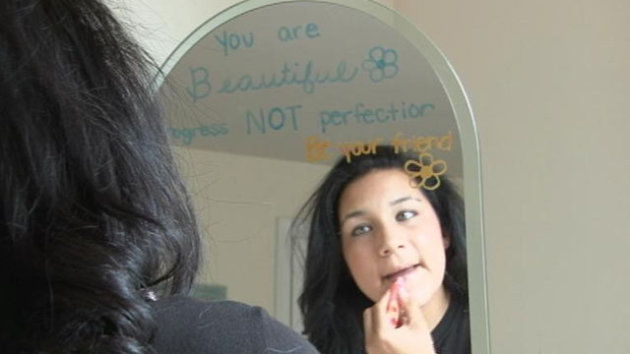By NIKKI BATTISTE and LAUREN EFFRON | ABC News
Taylor wants to like herself, but she can't turn off the voice inside her head that tells her she's not good enough and that the way she looks isn't perfect.
"It really feels like it is a second person inside of you," she said. "It's like your best friend but your enemy at the same time. It's hard to distinguish sometimes the ED talking and what's Taylor talking."
"ED" is the nickname Taylor, 20, gives to her eating disorder diagnosis, which, as she puts it, was "switched all over the place."
"Originally I was diagnosed with bulimia," she said. "Then my symptoms didn't match bulimia. So then they diagnosed me as anorexia, binge/purge type, because there are two different types. And then I didn't meet the weight criteria for anorexia. So then they said, 'OK, you have EDNOS.' And I was like, 'Well, what is that?'"
Watch "Nightline" anchor Cynthia McFadden's full report on EDNOS and those who suffer from it on "Nightline" TONIGHT at 11:35 p.m. ET
EDNOS stands for "eating disorder not otherwise specified," and up to 70 percent of all eating disorders come under the EDNOS banner. According to the National Association of Anorexia Nervosa and Associated Disorders, 24 million people in the U.S. of all ages and genders suffer from an eating disorder.
Many of the EDNOS symptoms are the same as other eating disorders, such as bulimia or anorexia, but don't fully meet the criteria of those disorders. On the other hand, EDNOS sufferers might exhibit a combination of eating disorders, such as being severely strict with counting calories but then still purging after eating.
The issues lie as much in the mind as in the meal, said Dr. Douglas Bunnell, a clinical psychologist and vice president of The Renfrew Center, a renowned eating disorder treatment program with 11 locations in nine states.
"It's still a misperception out there that these are relatively benign sorts of disorders or diets gone bad," Bunnell said. "These are life-threatening, serious illnesses. They have the highest mortality rate of any psychiatric diagnosis."
After receiving an EDNOS diagnosis, Taylor said she felt a little disappointed, as if her condition wasn't as serious as the more well-known eating disorders.
"Because you only hear about bulimia and anorexia," she said. "A lot of people don't think -- just because you don't meet the weight criteria, 'Oh, you don't have an eating disorder.'"
But EDNOS is a deadly condition, with a morality rate of 5.2 percent -- higher than both anorexia and bulimia -- despite the fact its sufferers often look healthy.
Taylor said her eating disorder began when she was 12, though she said the pressure to be thin started long before that.
"I remember asking the doctor when I was 6 years old why I had these fat thighs," she said.
Taylor said she had been secretly binging, purging and restricting calories all through high school, while keeping up with her dance team. Still, she says she has always felt fat and doesn't remember ever liking the way she looked.
"I always see the imperfections in every picture," she said.
Eventually, Taylor's eating behavior started destroying her health, and when she got to college, it went into crisis mode. After landing a spot on her college dance team, EDNOS sidelined her. Taylor said she began fainting at practice.
At her lowest point, she would eat only a stick of string cheese and then nothing else for three days.
EDNOS Sufferers Aren't Just Teenagers, But Adults Too
"I could sustain myself and I wouldn't be hungry," she said. "I would be at the gym for two or three hours every day after only eating a cheese stick and maybe nothing that day, and then I also would purge too."
EDNOS can be tricky to diagnose because it can include so many behaviors -- and not everyone suffering from EDNOS expresses all of them.
For 23-year-old Ali, once an Ivy League softball pitcher, EDNOS wasn't triggered by a desire to lose weight. When a shoulder injury sidelined her during college, Ali said she became obsessed with getting back on the field, and turned to extremely rigid diet rules and exercise in an effort to rebuild her strength.
"I had this idea that if I controlled [what I ate] I could never get hurt again," she said.
Ali said she became infatuated with healthy "super foods," or so-called clean, non-processed foods. She stuck to severely strict diet rules, including calorie counting.
"I ate for fuel," she said. "I didn't eat what I enjoyed. I ate what I needed for a workout, a little bit of quality carb and a protein. It was that specific."
Ali stopped seeing friends, stopped dating and worked out constantly. She even began carrying around her own cooler stocked with meals she had pre-measured.
"It was planning every single meal, portioning, measuring, so that I had just too not too much, not too little, just the right amount of the right foods, nothing else," she said. "If it wasn't the right food, I couldn't have it."
But it backfired. Ali said she stopped menstruating. She lost her ability to concentrate, frequently fainted and had night sweats as her body struggled to warm itself.
"I was just scared," she said. "I didn't know what was happening. I stood up to hand in an exam and face-planted in front of a room full of people."
Still, Ali said she struggled with the idea of having an eating disorder because she didn't fit the mold for anorexia or bulimia. Eventually she realized she needed to get help.
"I had dropped so much weight and lost so much power, I couldn't be what I was before," she said. "I gave myself no shot, but I couldn't see it then."
Ali and Taylor are both undergoing treatment at The Renfrew Center. At Renfrew, the philosophy is simple: The first necessity is to get the patients eating well and restore physical health. Then the long term focus is on the psyche -- finding the root of the destructive thoughts.
We have to eat at treatment so I always bring a sweatshirt so you can't see my bloating after meals," Taylor said. "Yeah, it's still a part of the body image that I see."
At Renfrew, numbers are not allowed: No calorie counting, no scales and no talk of pounds. It's a change that brings anxiety to many patients, including Taylor, who said she used to weigh herself seven to 14 times a day.
Not just college-aged girls are here, but grown women too.
Chloe, a 36-year-old assistant professor and mother of three young children, said she went back and forth between binging and restricting, starting when she was 12.
"I tried to purge and I was totally unsuccessful, and I remember writing really bad poetry about trying to stick a toothbrush down my throat and making my throat bleed."
Chloe, once an aspiring dancer, said she first turned to food to numb emotional pain, but as she became an adult, her eating disorder became about having control of her body.
With EDNOS, Comes Great Anxiety
"I feel so strong when I'm not eating and I feel success and such power and such control when I'm not feeding my body," she said. "I get a hollow sense in my stomach where I feel really thin and that feels good."
Chloe said she began carrying a food scale with her, weighing every bite she ate. She would eat two pounds of vegetables a day and consumed so many carrots that her skin turned orange.
As part of their treatment, Renfrew patients have to eat what are called their "fear foods," and each patient has a long list of foods they are terrified to eat.
"My fear food would be chocolate milk," Taylor said. "Dessert, ice cream in particular, pasta, fries, really anything I considered as bad food, which they teach you that there is no such thing as bad food. But really processed foods, stuff like that. Crackers, those would be my binging foods that I would go on and purge those."
Each meal is monitored by a therapist and must be eaten within an hour. Taylor battled with her anxiety when she was served spaghetti.
"My chest is tight, my stomach just feels very full," she said. "I feel like I want to cry. I'm trying to control my breathing or else I'll start hyperventilating, but sometimes when I feel this full it leads to a panic attacks."
So much of EDNOS is secretive, and Taylor said she had always eaten her meals in isolation before her diagnosis. But after meals, patients have meal-support group therapy sessions to talk about how they are feeling.
As her treatment progressed, Taylor said she began to start to "taste food" for the first time, but still broke down several times and cried at meals. Six weeks after she struggled to eat pasta, Taylor was presented with pizza as a "challenge meal" since it included one her fear foods. After cleaning her plate -- which is the goal at Renfrew -- she told the therapist eating her meal was still very hard.
"Physically, I'm probably an 8 [on a scale of 1 to 10], which is normally a really comfortable place for me to be," she said. "But with my emotions, I didn't have that much anxiety coming into it, but then once I saw [the pizza] all on the plate and then seeing it now [empty], I like I'm over a 10 right now and I don't feel good."
Watch Taylor and Ali as their treatment progresses at The Renfrew Center on "Nightline" TONIGHT at 11:35 p.m. ET
Also ReadEXPLORE RELATED CONTENT
1 - 4 of 20
- From Dr. Douglas Bunnell, a clinical psychologist and vice president of The Renfrew Center, a renowned … Full Story »ABC News (RSS)
- Los Angeles Eating Disorder Expert Discusses Exercise Bulimia on Popular Talk ShowLos Angeles, CA (PRWEB) … Full Story »PRWeb


No comments:
Post a Comment